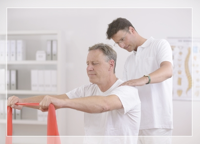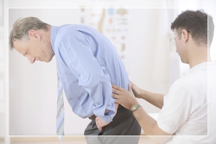Surprising Truths About Degenerative Disc Disease
Degenerative disc disease, despite the name, is not a disease but a deterioration of the discs of the spine. It occurs over a period of time, resulting in neck or back pain and other musculoskeletal and neurological symptoms. It is common in adults as early as their thirties.
Types of degenerative disc disease
- Cervical: affects the neck and is referred to as cervical degenerative disc disease
- Lumbar: affects the lower back and is called lumbar degenerative disc disease
The cervical and lumbar regions of the spine are susceptible to damage due to increased movement capabilities and our current postural trends with the increased use of small electronic devices and tendency to sit for prolonged periods with work, school, and driving. Additionally, physiologically our bodies do change as we age. Our discs lose water and the protein content of the cartilage changes and our discs become weaker. As degenerative disc disease progresses our spine may become unstable and we begin to see isolated movement between the spinal segments. So what causes the symptoms? As these degenerative changes progress, injury or symptoms may become noticeable after an isolated event (motor vehicle accident, slip & fall, or simply reaching over to pick a small object up from the floor) or the symptoms may change over time (back or neck begin to stiffen with prolonged use). What is important to understand is that the instability of the spine now allows structures to move around that shouldn’t and when the brain senses this it sends the surrounding muscles into spasm as a protection mechanism. It is typically this spasm that causes the symptom of pain. Important note: these muscle spasms may not be full on cramping or “charlie horse” type sensation. These spasms may only be detected by palpation from a massage therapist, physical therapist, chiropractor, or physician.
Signs and Symptoms of DDD
Most patients report one or more of the following symptoms.
- Pain triggered by activity
- Pain flares up periodically and then settles to a low-grade pain/discomfort
- Sitting or standing for long periods of time worsen the pain
- Activities such as walking may alleviate the pain
- Relief upon changing body position
- Muscle spasms
- Tingling sensations in the extremities
It is important to note any activity that triggers pain in the neck or lower back and save that information for your physical therapist. If there is no relief with rest, consult with a physical therapist. Early intervention could save you from further damage to the disc, muscles and ligaments and speed recovery.
Management of Degenerative Disc Disease
Physical therapy helps treat the underlying factors such as the instability of the intervertebral joints and the associated inflammation. Your physician may recommend prescription medication to provide relief. Once the pain is reduced, specific therapeutic activities and specialized physical therapy techniques are utilized to achieve lasting relief.
Treatment falls into one of the following three categories:
Medical
- Pain control with acetaminophen, prescription medications, narcotics, etc.
- Nonsteroidal anti-inflammatory medication (NSAID, steroid injection etc.)
Surgical (if required)
- Fusion of the discs
- Replacement of the damaged disc with an artificial disc
Conservative (Physical therapy)
- Therapeutic Activities: Progressive controlled activities under supervision. These may include stretching, strengthening and functional movements.
- Lifestyle modification: Understanding the importance of controlling destructive forces. Improved posture and movement patterns reduce stress on the spine. Ergonomically designed chairs can also relieve pressure on the spine.
- Self-care including weight management, treatment of depression, etc.
A Stronger Spine
Prevention Tips
Poor posture, especially in a sitting position, can cause bone & joint and muscle changes over time and has been linked to increased incidents of heart disease, colon cancer, and earlier death. If your job is sedentary it is important to:
linked to increased incidents of heart disease, colon cancer, and earlier death. If your job is sedentary it is important to:
- Control the destructive force! STOP the problem before it starts. With that we recommend that you physically get out of the seated position every 40 minutes. If you have the option of an adjustable standing desk go for that. If you don’t want to buy a whole new desk our recommendation is a Varidesk which can be placed directly on your current desk.
- Perform therapeutic activities at regular intervals that have been designed specifically for you. We often get asked what are the 3 exercises everyone should do to reverse this and my answer is I have no idea because your pain may be from tight glutes, tight back, tight hamstring, tight calves, weak neck muscles, loss of core control, inhibited glutes, inhibited low back muscles…or any combination of the above. This is why we exist to figure it out and then give you your recipe for success.
- Adjust the height of your desk chair and computer to minimize strain on your neck and lower back. (Come to our office for an evaluation and we will identify the most appropriate height for you).
- Invest in footwear to reduce stress on the lower back.
Call our office without delay if you are at risk of developing DDD. If you, or someone you know, has been diagnosed with DDD, a physical therapy program, combined with traditional medicine, is critical for recovery.
Physical therapy interventions include:
- Strengthening/motor control
- Postural retraining
- Ergonomic intervention
- Use of modalities including electrical stimulation for muscle reeducation
The fast-acting techniques used during your Physical Therapy session will improve blood circulation allowing the spasming muscles to relax and return to normal functions. Additionally, these techniques aid in pain reduction by facilitating the release of endorphins (our body’s natural pain killers). The long-term goal is to reestablish your optimal range of motion & flexibility and progress the functional strength of your spine and how it interacts with the rest of your body during functional movements (lifting, walking, climbing, sitting, & standing). Our programs are designed specifically to your body, your movements, & your lifestyle! Call us today at 281-488-5877 to learn more about what Valeo Physical Therapy can do for you.
1235 Clear Lake City Blvd, Suite F
Houston, TX 77062
www.ValeoPT.com
www.Valeo-Fit.com


